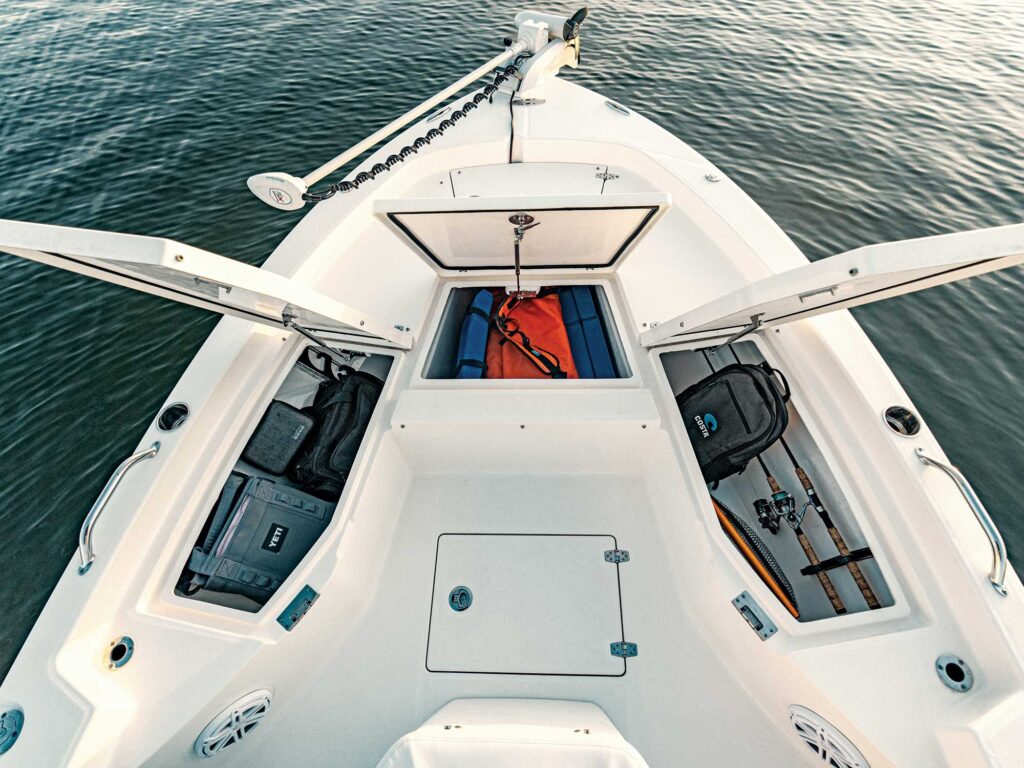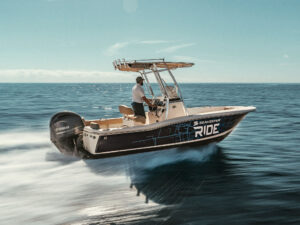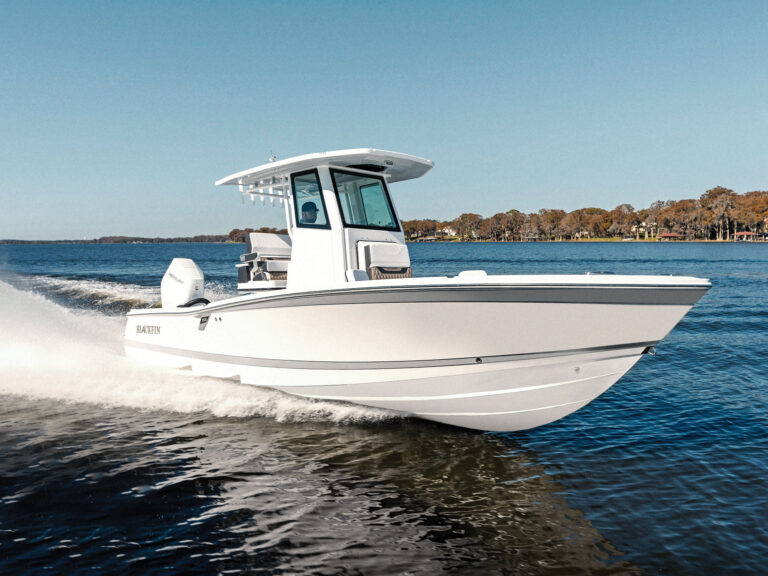
The Pathfinder 2200 TRS is likely Pathfinder’s most popular bay boat, which begs the question: Why retool it? Short answer: To make it even better. And in this effort, Pathfinder succeeded.
It is unlikely any fisherman will ply salty coastal waters without encountering at least one or more Pathfinder boats out there. Anybody who knows boats knows what is meant by the utterance of Pathfinder. So, as I stepped aboard the new Pathfinder 2200 TRS, I felt a mixture of giddy anticipation and Missouri “show me” attitude—until I began opening hatches.
The foredeck was covered in comfortable, removable cushions, and included innovative forward-facing backrests that turn when not in use to create more space. The casting deck under the upholstery is divided into four hatches. Rod lockers on port and starboard open from the aft end, which allows you to load them when the boat is on the trailer. Stainless-steel gas shocks hold the hatches open and work conveniently, even with the cushions on. The rod lockers flank a center dry locker and a forward anchor locker. With oversized gutters and drain, the lockers will stay very dry. This deck treatment definitely panders to anglers while also pampering sun worshippers with the cushions.

Thanks to the new longer running surface, the cockpit provides more space to move about. This is especially evident behind the newly designed optional leaning post with four rod holders and a large slide-out Engel cooler.
The aft casting platform now features a comfy two-person foldout seat set in the center, thus staying true to the TRS (Third Row Seating) designation. This replaces a pair of single jump seats port and starboard and accomplishes four things. First, it moves anglers from the gunwales on the old 2200 TRS to the center, with protection provided by the helm, leaning post and hardtop. Second, it moves crew weight to the centerline, improving balance and ride. Third, it grants more convenient access to the standard livewell portside and the optional well to starboard. Finally, access to the bilge, pumps and plumbing is improved by swinging the new, large center seat forward to reveal a lift-out fiberglass storage “bucket.”
The hardtop and leaning post stand on highly polished aluminum pipework with the option to powdercoat white or black. Four rod holders, flanked by kingfish rod holders, reside there. The hardtop is slotted to accept longer rods in the four rod holders on each side of the console. EVA foam mats under the gunwales protect rods stored there. It is clear Pathfinder’s goal is to keep anglers’ tackle in top shape.

Artful may be the best way to describe the wiring of the boat. Move the removable console cooler seat and the entire front of the console opens up with double Dutch doors for great access to the back of the electronics and batteries. More impressive is the quality of the wiring. Few production boats boast such clearly laid out schemes, with wires labeled at all terminals, and switches easy to reach and diagnose if ever required years down the road. The circuit breakers are visible and easily accessible.
Typically, a new model introduction brings out minor deck features, and upholstery and accessory changes, but Pathfinder’s retooling of the 2200 TRS is far more extensive and a clear nod to angler feedback on the long-running success of the model. But this boat also featured a new flat transom design to accept a pair of Power-Pole shallow-water anchors, while still allowing room to keep the integrated swim platform with a foldaway stainless-steel ladder for easy boarding. The boat can also be optioned with an Atlas jack plate allowing for even better shallow-water capability. However, another benefit of the jack plate is to tune the performance of this sweet-running hull. We used 1 inch of elevation for optimizing speed and handling. In heavier chop, a pair of tabs was helpful and the 2200 TRS ran though the waves with ease. But with tabs retracted and the jack plate skillfully elevated, we made 50 mph with the 250 hp Yamaha outboard.
I would order the max 250 hp with this boat, and here’s why. In a trial, straight-ahead speed is a measure of performance, but not really an attribute that matters most in everyday fishing. What does matter is a quick hole shot and jump-to-planing speed. That extra horsepower also gives the vessel the ability to stay on plane with power to spare at lower speeds, important when spanning chop. Also important is the ability to hold the boat on top during turns. While the sharp, hard-over turns we do in testing aren’t typical to boating, they were demonstrative to the rig’s ability to stay on plane and come around the turn sweetly.
Read Next: Pathfinder 2400 Open

That said, one of my fishing buddies has an older 2200 with Yamaha’s four-cylinder 200 hp outboard. It hits mid-40s in speed, trims well, and holds its own against rough water. In addition, the lighter motor on the transom can improve skinny-water access, depending on how you load it, and it can save bucks at the contract signing. But ignore promises of saved fuel. In everyday boating, we want our boat to run the way we want it to run, and we’ll press the throttle deeper to get it.
Usually, the enemy of best is better, but Pathfinder’s engineers outsmarted that old saw. This new bay boat is destined to become the new favorite.
Specifications
| Length: | 22’5″ |
| Beam: | 8’6″ |
| Draft: | 1’1″ |
| Weight: | 3,275 lb. (w/ Yamaha F150) |
| Fuel: | 65 gal. |
| Max HP: | 250 |
| Price: | Starts at $78,054 (w/ Yamaha F150 |
Pathfinder – Fort Pierce, Florida; pathfinderboats.com









